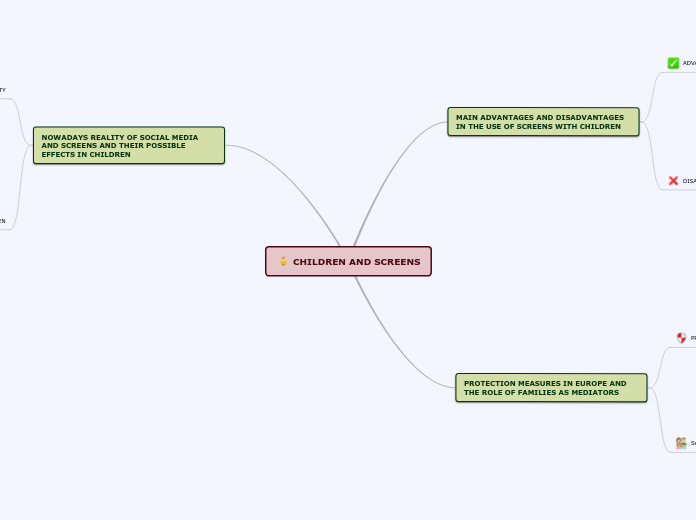CHILDREN AND SCREENS
MAIN ADVANTAGES AND DISADVANTAGES IN THE USE OF SCREENS WITH CHILDREN
ADVANTAGES
Audiovisual products are able to broaden horizonts by showing them different realities and opening a gateway into the world
Exposure to quality content can enhace social and language skills (2/+ yaers old)
Audiovisual products may inspire and encourage children to try new things
Entertainment may help them developing skills, improving creativity and resources to solve problems, whithout even noticing it
DISADVANTAGES
Preschoolers learn best through face-to-face interaction
Can cause them addiction which might end up with vision problems and obesity
Prolonged TV viewing might lower cognitive abilities related to short-term memory, early reading, math skills and language development
Children who watch television for more than two hours a day can have behavioral problems
PROTECTION MEASURES IN EUROPE AND THE ROLE OF FAMILIES AS MEDIATORS
PROTECTION MEASURES
New and higher quality content and services, dedicated to children, have to be developed
Children have particular needs and vulnerabilities on the Internet, which must be addressed specifically
Unlock the potential of the market for interactive, creative and educational online content
Combat child sexual abuse material online and child sexual exploitation
Subtopic
The role of families as mediators is very important because it improves learning and understanding and it helps stablishing health routines
There are a number of ways parents can use media together with their young children to encourage family connection, learning, and digital literacy skills
Parents should feel comfortable seeing digital media as a tool to meet their parenting need
NOWADAYS REALITY OF SOCIAL MEDIA AND SCREENS AND THEIR POSSIBLE EFFECTS IN CHILDREN
NOWADAYS REALITY
Children start to interact with digital media as young as 4 months of age
2 years old children use mobile devices daily and the majority of 1 year old use a mobile device
Preschoolers are already starting to media-multitask, for example using an iPad while watching TV
Three quarters of teenagers own a smartphone. 24% describe themselves as constantly connected and 50% report feeling "addicted". The ones belonging to that 50% have higher rates of mental health problems
Teens who report feeling "addicted have higher rates of mental health problems
EFFECTS IN CHILDREN
Breakdown of empathy between children
Increasingly distracted famili interaction
Growing need for constant stimulus
Infatuation with life on screens rather than life in the real world
Early expose to inappropiate content
